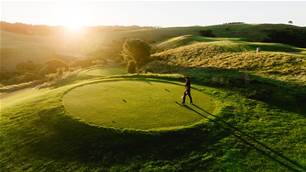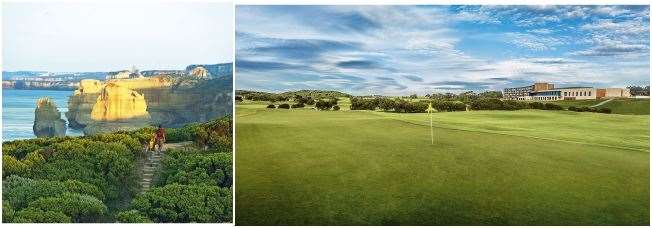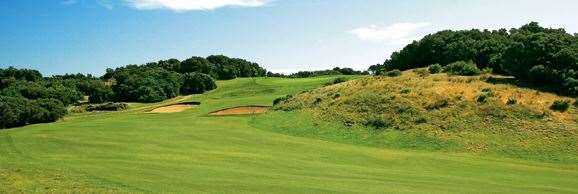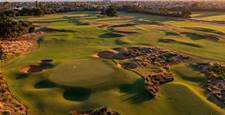Victoria's iconic Great Ocean Road has some of the country's most spectacular natural attractions. The key to a getaway here though is to not forget the golf clubs.
BY BRENDAN JAMES
Victoria’s Great Ocean Road is famous as a spectacular touring route that boasts some of the most beautiful coastal scenery in the world. Home to quaint seaside towns, white sandy beaches, rainforests, bushland and an abundance of native wildlife, the Great Ocean Road is not just a beautiful driving destination, but the ideal location to experience the great outdoors.
Many, for example, choose to venture along the Great Ocean Walk, from Apollo Bay to the magnificent Twelve Apostles, which weaves through beautiful parks, deserted beaches and rugged coastline. Others find their own way to soak in the amazing natural attractions and also reserve time to play some of the wonderful golf courses along the route between Torquay and Port Fairy.
The Sands Torquay celebrates its 10th anniversary this year after a decade of establishing itself as one of the premier golf courses in the region.
As the name suggests, sand dominates the landscape of this layout, which was designed by Stuart Appleby in collaboration with Brit Stenson, from the International Management Group design team.
The design team was obviously influenced by Dr Alister MacKenzie’s bunker work on the Melbourne Sandbelt.
A case in point is the opening tee shot that looks far more intimidating than it actually is. Standing on the championship tee of the 357-metre par-4 1st, it seems there is absolutely no landing area for your drive. A quick glance at the course guide confirms there is plenty of room between the bunkers left and right. However, a greenside trap to the right of the putting surface in the distance fills the visual void between the fairway bunkers. The ‘dead’ ground that can’t be seen from the tee and the bunker placement deceives you into thinking there is nothing but sand strewn across the fairway.
The 401-metre par-14th is one of the most beautiful holes at The Sands. Laid out on land that was formerly part of the Torquay rubbish tip, there are seven bunkers ready to halt your progress along this fairway, which is set on the edge of a ridge and features a steep slope down off its right edge. The putting surface is also set carefully on a sideslope, with mis-hits right or long of the green finding inevitable trouble.
The Sands Torquay is a private member’s course but access to the course is available for interstate and overseas visitors by prior arrangement as well as for guests staying at the adjoining Peppers Resort.
RACV TORQUAY RESORT
Perched within the backdrop of the Torquay and Jan Juc beaches, RACV Torquay Resort is set on an expansive golf course with spectacular ocean views and direct beach access.
The 18-hole links-style layout has recently been redesigned by Ogilvy/Clayton – the Melbourne-based design team of 2006 US Open champion Geoff Ogilvy and former Tour player Mike Clayton. The fully irrigated par-71 layout has been crafted to feature wide couch fairways, fescue roughs, wetlands and ocean views.
Firm conditions and the ever-present wind, which goes hand-in-hand with its coastal location, encourage the links-style ground game and Ogilvy/Clayton’s creation takes this into account. For example, the simple bunkering is relatively small but in many cases the surrounds are contoured to feed balls into the sand. The greens feature subtle slopes and are receptive to running shots, especially those played from the correct side of the fairway.
Four holes on the front nine are played around a large salt marsh that has been created to help with drainage and improve the look of the layout.
The centrepiece of the recently completed course is the RACV’s stunning five-storey, $115 million Torquay Resort, which was opened last December by Prime Minister Tony Abbott. It coincided with the RACV’s 110th anniversary.
“With more than 2.1 million members spread across Victoria, RACV had been looking for some time for an RACV Resort to better serve the holiday and leisure needs of our members located on the western side of Melbourne and the western side of the state,” RACV president and chairman Ross Herron said.
“Nearly 60,000 RACV members live within a 30-minute drive of the Torquay Resort and many more own holiday homes in the area.”
ANGLESEA GOLF CLUB
Located at the eastern gateway to the Great Ocean Road, Anglesea is a picturesque seaside town that really swells in population during the summer months.
One of the favourite attractions for tourists is the Anglesea course – a wonderful par-73 layout, which is also home to hundreds of Eastern Grey kangaroos.
For golfers the real attraction is the Vern Morcom-designed 6,028-metre layout that features gum tree-lined fairways and bunkering that looks remarkably similar to those found on Melbourne’s famous Sandbelt courses. There are only 42 bunkers scattered across the course but they have been well positioned to add to the challenge of a design that twists and turns across the undulating landscape.
Your score can really be made or broken on the front nine. There are three par-5s and a short par-4 that present birdie opportunities for better players but stern tests occur in between.
The most difficult par-3 at Anglesea is the 176-metre uphill 6th hole, where good scoring over the opening five holes can come to a halt with poor club selection or a mis-hit. A narrow opening between the front bunkers allows you to run a tee shot onto the green, which slopes markedly from right to left.
The par-5 8th hole is a definite birdie chance for most players. At 461 metres, the hole doglegs sharply left and plunges downhill before rising again on approach to the green. There are two definite playing lines en route to the green. Longer hitters can drive over the treeline down the left side, while other players can stick to the right but they need to avoid a sandy wasteland and a fairway bunker.
Another chance for bettering your score comes at the final hole. The 455-metre par-5 18th hole is one of the best looking closing holes you will find along the Great Ocean Road. It can be reached in two blows by many players and the temptation for many is too great, which can be to the undoing of some players, who mis-hit their second shot. From an elevated tee, the drive is played to a wide fairway. Depending on the wind of the day, players might only need a long iron to find the elevated green in two. It is a shot that must negotiate a deep bunker short and left, as well as another 50 metres short of the putting surface on the right side of the fairway. Finding the green leaves plenty of work to be done with the putting surface featuring four levels and a variety of breaks.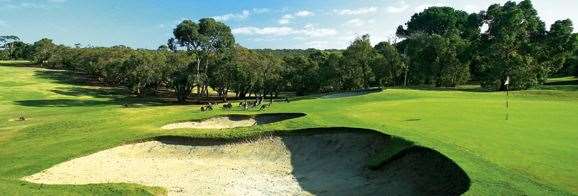
LORNE COUNTRY CLUB
With its fresh sea air, white beaches and relaxed Mediterranean atmosphere, Lorne has been attracting holiday makers for more than a century. Whether you’re staying overnight or just passing through, take time out to wander down Lorne’s main shopping strip, which features boutiques, cellars, fine cafés and eateries.
Then, if you have your clubs, drop by for a hit at the nine-hole Lorne Country Club, which is perched high above the resort town. The views across Louttit Bay and the Southern Ocean from the clubhouse and various parts of course are spectacular and well worth the $35 green fee.
APOLLO BAY GOLF CLUB
When en route to the Twelve Apostles, stop into the beautiful seaside village of Apollo Bay at the foothills of the mighty Otways. Hit the waters of the Southern Ocean or enjoy the fruits of the sea caught by local fishermen.
Apollo Bay is the ideal base to explore the famous Twelve Apostles as well as the vast Otway Ranges. There is also a beautiful nine-hole layout, with green fees of just $25 for 18 holes, where you can satisfy your golfing desires with most holes offering a view over nearby Boat Harbour.
WARRNAMBOOL GOLF CLUB
Warrnambool is the largest town along what is known as the ‘Shipwreck Coast’, based on the 180-plus ships that have come to grief along the rugged stretch of coastline.
Located just 12 kilometres from the western end of the Great Ocean Road, the town covers a plateau behind a steep bluff overlooking Lady Bay and the surrounding terrain has given rise to a wonderful course.
From the moment you turn into the driveway of Warrnambool Golf Club, there is no mistaking who the favourite golfing son of Warrnambool is. Marc Leishman Drive leads you to the clubhouse and when you venture inside there is plenty of memorabilia, generously donated by the PGA Tour player, in the foyer and adorning the walls. A glass cabinet with a signed golf bag and a few scorecards, including his Warrnambool course-record card, are just some of the interesting items on display.
Leishman is a much-loved golfing hero in these parts. And why wouldn’t he be? He learned and honed his game here and was well-supported by the proud members in the early days of his golfing career. When he returns home from playing in the United States all year, he always makes time to tee it up in the club competition with a few members and share a few stories around the bar.
To look at the strengths of Leishman’s game – long hitting, precise iron play with a variety of shots in all conditions – you need look no further than the holes covering the varied terrain surrounding the Warrnambool clubhouse to see how the foundations of his enviable swing were formed.
The majority of the layout covers landscape formed by sand dunes, while the routing is predominantly lined by coastal ti-tree. For mine, the highlights of the course are on the front nine with the two short par-4s – the 311-metre 4th and 327-metre 5th holes – being the most memorable.
The 4th demands a well-struck tee shot – perhaps with a fairway wood – to ensure you find the short grass and avoid the out-of-bounds to the right. A large dune blocks your view of the elevated green from the right half of the fairway, so an approach from the left is a better line. Correct club selection from the fairway is vital as shots that fall short will roll back down the fairway, and long shots can run into trees and scrub.
The 5th hole is a gem. The elevated tee not only offers ocean views but it leaves you in no doubt that a mis-hit drive away from the narrow fairway will result in a lost ball as thick scrub and trees line both sides of the fairway all the way to the green. This hole might be short but it demands precision hitting, even from the fairway with a short iron as the green slopes markedly from back to front.
PORT FAIRY GOLF CLUB
While the Warrnambool course offers the occasional glimpse of the sea, the links layout at Port Fairy – just 20 minutes’ drive to the west – brings you right up to the ocean’s edge.
Port Fairy’s natural setting encapsulates all the endearing qualities of the great links layouts of Britain and Ireland with wild windswept holes rolling between and over sand dunes.
Port Fairy would not be out of place on the east coast of Scotland or along an isolated beach in north-western Ireland. Instead it is 300 kilometres west of Melbourne on a stretch of coastline seemingly purpose-built by Mother Nature to be home to a links course.
Routed along rows of rolling unspoilt sand dunes, Port Fairy is classic links where no two days on course are the same, thanks to the wind, but the golf is fun, not brutal.
Golf has been played on the present site since 1963, even though Port Fairy Golf Club was first founded in 1901. It was a nine-hole layout for more than 20 years before expanding to 18 holes in 1985. In 2000, the club commissioned Mike Clayton to oversee any further changes to the layout.
“Port Fairy is a precious and unique layout. Nowhere else in Victoria is golf played so close to the ocean or along dune land of such quality,” Clayton says. “The gently rolling sand dunes at Port Fairy have been largely unaltered by man, only mown in order to define fairways and rough, giving rise to a wonderful natural feel.”
It is easy to see why golfers from near and far have been inspired to make the journey to this relatively remote par-72 by the sea. The golf aside, there are great views of the Southern Ocean from several holes and between June and October you can see whales breaching just offshore.
The front nine holes have been laid among the dunes furthest from the beach and run predominantly north and south. The one exception is the 122-metre par-3 8th that is played to the west and is easily affected by the prevailing southerly winds, blowing high-struck tee shots to the right of the green and towards two deep bunkers.
Port Fairy’s most exciting holes are incorporated into the stretch from the par-5 12th to the par-4 16th. The ocean comes into view for the first time as you walk onto the tee of the 465-metre 12th. It is a straightforward three-shotter with out-of-bounds on the beach to the right of the fairway and tall Marram grass rough to the left. The key here is not to be distracted by the view and keep your shots low and out of the wind.
The toughest of Port Fairy’s holes is the 408-metre par-4 14th where, again, out-of-bounds lines the right of the fairway. When the wind is blowing hard off the sea from the right it might be necessary to hit your drive out over the boundary fence to allow the wind to bring it back to the middle of the fairway. The second shot here is breathtaking. It doesn’t get much better than having to play any number of clubs (depending on the wind strength) to a small green set against a Southern Ocean backdrop.
A spectacular redesign of the 178-metre par-3 15th in 2006 changed the direction of the hole to run along the coastline and it has proven to be a masterstroke. The 15th has now become the hardest par-3 on the course and it is destined to receive higher acclaim as more golfers play it.
The short par-4 16th is also a memorable hole. Again, the sea dominates the panoramic views from the tee. Down the fairway, a blind tee shot must be struck over the edge of a bunker on the inside of the dogleg-left fairway. This will leave an uphill approach, hitting away from the beach, to a green that slopes markedly from back to front.
Generally, the playing conditions here are firm and fast and being able to control your ball close to the ground and out of the wind is vital for good scoring – just like playing the more revered links courses of Great Britain and Ireland.
Related Articles

International Spotlight: Omanu Golf Club
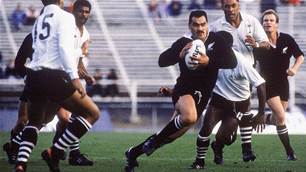
Celebrity Kiwi couple tee off in paradise
